For your electronic drum kit to sound its best whether you’re performing or practicing, you’ll need a predictable and extremely capable snare pad. A snare pad is arguably one of the most important components of an electronic kit.
Ideally, drummers playing on an electronic snare drum want it to be every bit as dynamic as an acoustic snare. Capable of rim shots, cross sticking, as well a number of sounds that match the velocity of your strikes.
Top 3 - Electronic Snare Drums
Picking the right electronic snare drum involves more than just matching the appearance and sampled sound of an acoustic snare. The electronic version must be sophisticated enough to be tuned like a real snare drum and respond similarly.
The tightness and tension of a snare — even without changing pitch — affects how it responds to different hitting intensities and shapes your overall beat's feel.
Multiple sensors are essential to capture the various dynamic levels and zones where an acoustic snare would produce different responses. Each zone needs to correspond to specific samples that sound authentic to that particular area.
These features distinguish acoustic snares from simple triggers or pads. Fortunately, technology has evolved significantly since the early days of basic rubber pads that functioned merely as triggers, and now electronic snare drums have the most essential qualities of their acoustic counterparts.
If you’re thinking about upgrading your e-snare, you’re in the right place. I recently tested out some of the newest entries to the e-snare market and here are my findings!
Best Electronic Snare Drums - My Top Picks
1. Roland V-Pad PD-140DS
What a lot of drummers will like about this pad right out of the gate is its size. It looks like a real snare drum. The polished metal shell is sharp looking but prone to fingerprints. You may have to wipe it down every so often.
This e-snare pad from Roland is a full 14” in diameter and mounts on a traditional snare stand. Drummers will not have to adjust their playstyle at all while jamming on this pad. It feels like the real deal!
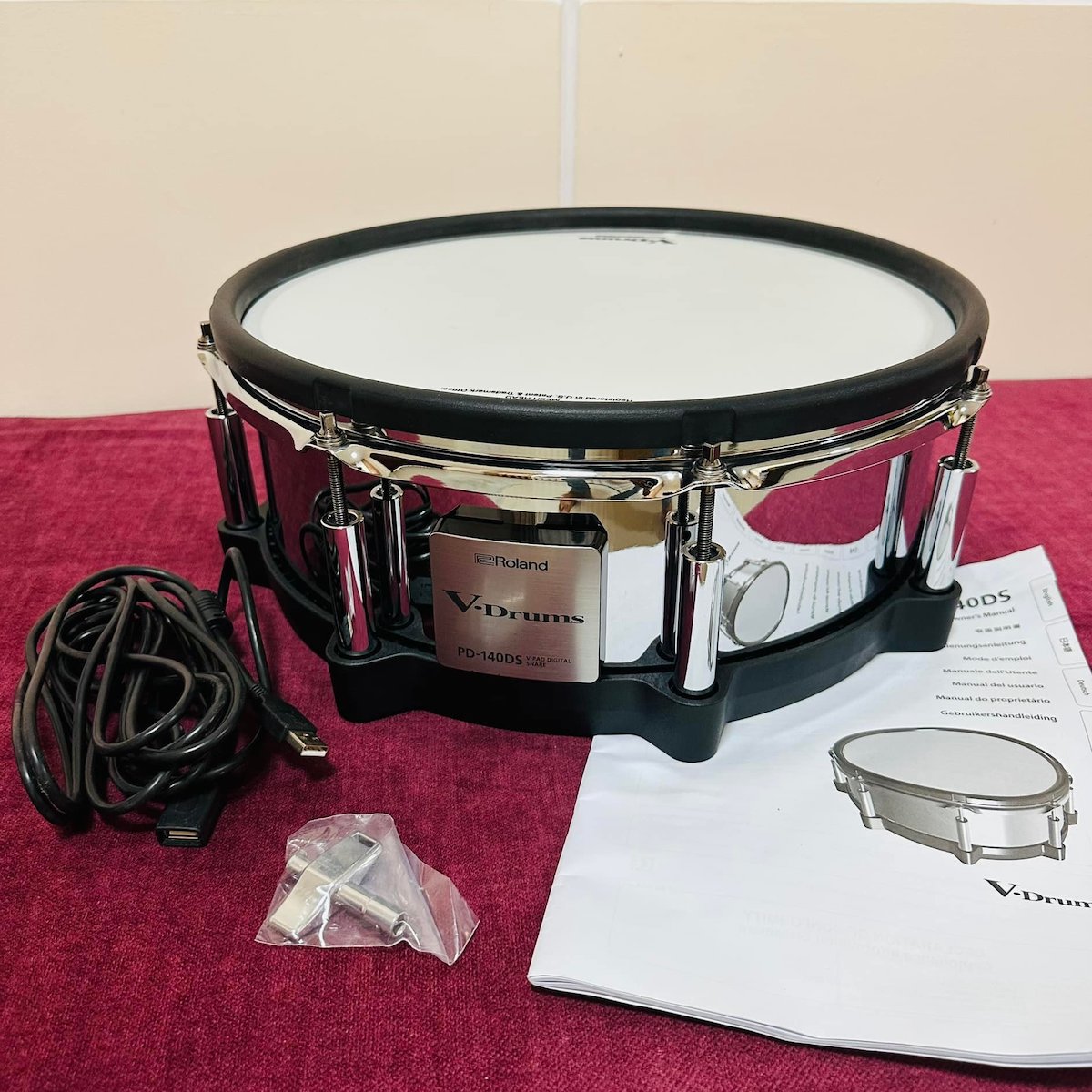
Roland V-Pad PD-140DS
The pronounced rim of the drum makes it easy to get rim shots when you want them. You don’t have to strike it too hard, which is really nice as this reduces shock through the hand. You can even let your stick dance on the head to get ghost notes when desired.
One of my greatest gripes about early electronic drum triggers was the lack of mesh head tension and the overall fake feel of the old rubber heads. I waited years for companies to really evolve and get their electronic drum pads right, and I think we're finally at the peak of great drum pad manufacturing.
Companies like Roland are truly listening to both their pro players' feedback and the public about what makes a difference when using drum pads versus acoustic snares. One thing that always comes up — and I've said it myself — is that when you tune or gaff tape your snare drums tighter, it significantly affects the way you play.
I particularly love having a lot of tension on my snares because I like to play modern beats in styles like hip-hop, pop, and electronic music. For that particular sound, I've always wanted a snare that felt tighter.
The challenge is that I also prefer snares that sound deep. For real acoustic snares, I've always chosen vintage-style deeper snares that I control with electrical tape and precise tuning.
I was concerned when I got this Roland drum pad that I wouldn't be able to achieve the feel I was looking for, but I was happily rewarded with a very sophisticated snare — possibly the best mesh head they've ever created — because it truly responds as you tighten it.
Another great thing about using electronic drum pads is that you can have the best of both worlds: a tight, responsive feel from the physical mesh head without altering the sound, since you're using samples. You can have a tight snare that's still deep and open — something impossible with a real acoustic snare.
With an acoustic snare, if you tightened it that much, it would be dampened. You don't have to worry about that with the Roland V-pad — it's far more versatile. Plus, you can use brushes, and it will capture the brush sweep.
That's remarkable considering how complex it is for the zones and trigger areas to intelligently switch between strike versus sweep. I expected lag or misfires — where it might see a sweep as a strike or vice versa — but that wasn't the case.
Similarly, I was pleasantly surprised that it always detected the difference between a horizontal rim shot pattern and a strike with just a touch of rim harmonic. I know you understand what I mean by that technique.
Sometimes when I'm doing a snare fill, I like to strike the very edge of the snare to get that metallic, tambourine-like bit of rim in the sound. This makes it feel more like a cutting, powerful snare fill versus a military-style drumline fill.
The moment I got this drum pad, that was one of the first things I tested. I was amazed that it actually differentiated between partial rim with snare and full-on rim shot. It switched samples accordingly — that's incredible technology.
Another crucial aspect of testing electronic snares is the difference between ghost notes and rolls. Many multi-sampled, dynamic module libraries, like those that come with the Roland drum pad, have separate samples for drumline-style rolls and ghost notes.
This distinction is vital because you don't want ghost notes — those subtle rhythmic touches between shuffling your snare pattern — to sound like you're beginning a drum fill or playing a military-style drumline.
I've heard modules that don't get this right, and it's atrocious. Fortunately, the TD-27 and TD-50 modules can tell the difference between these playing styles. If your budget allows, I'd recommend spending more for the TD-50, as the trigger sensitivity and response speed seem noticeably faster and more precise, though the TD-27 is more than adequate for most drummers.
Again, that could come in handy if you're serious about recording this kit in the studio, as the TD-50 module does have some sonic advantages.
The triggers were responsive to my playing. I didn't find myself struggling to get what I wanted out of this pad. In fact, the trigger zones in Roland V-drum pads as advanced as this one help with playing precision.
I've always struggled to get my ghost notes right in a Jeff Porcaro-style shuffle beat — loud enough without muddying up the beat. I know some of you understand what I mean: you need the ghost strokes to help the hi-hat pattern groove, but you don't want them so loud that they sound like rolls.
This takes lots of practice to get right on acoustic snares, and if you switch to an unfamiliar kit, it can be really hard to control this aspect of your playing. Also, tightening your snare too much can inhibit how the snare coils react, so I was incredibly relieved at how well this snare handles both soft and loud ghost strokes between strikes.
Around the 3-ply mesh head are 8 easily accessible lugs, so drummers can dial in their optimal level of tension. As it has come to be expected from Roland, the V-Pad mesh head provides very clean, articulate feedback while playing.
Though there seemed to be a reduced level of bounce to this head compared to previous models from Roland. This could be due to the 3-ply mesh head. I didn’t find it to be a bad thing for how I play but, I felt it was worth noting for any long-term Roland users.
2. Roland V-Drums PDX-12
The Roland PDX-12 may seem familiar as it is the same snare that comes with Roland’s TD-17KV drum kit.
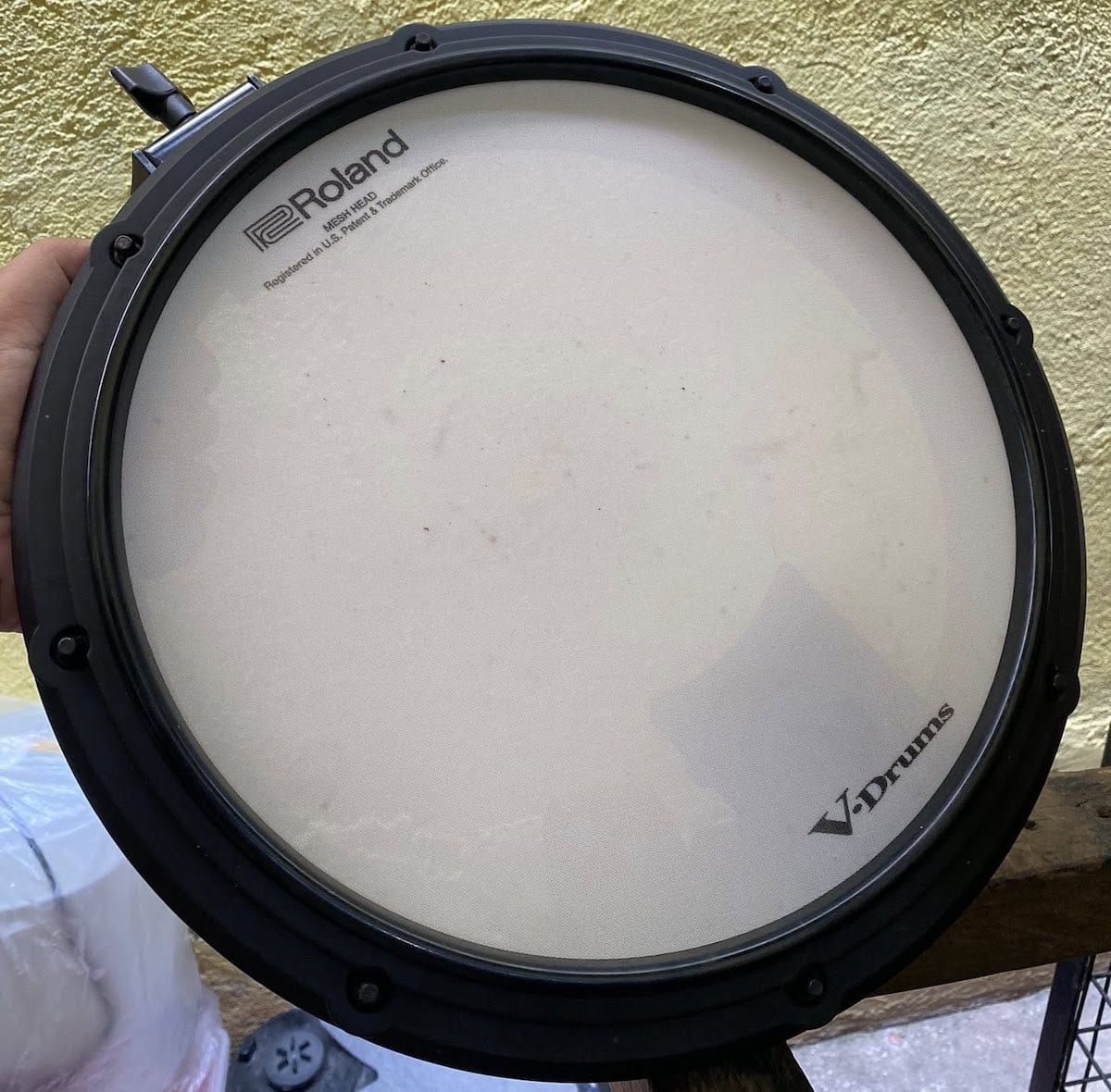
Roland V-Drums PDX-12
The PDX-12 has a simple but effective design featuring a dual mesh head and dual-zone trigger system that allows drummers to play both the adjustable primary mesh head, as well as the rim area.
Players who are transitioning frequently from an acoustic kit to an electronic kit will enjoy this larger-than-average-sized electronic snare pad.
While the PDX-12 is not as impressive looking as some of its counterparts you’ll find that it can absolutely get the job done. The triggers are accurate. Drummers will be able to play flams, drum-rolls, perform cross-stick patterns, and play dynamically with ease.
The simple design will be appreciated by drummers who have a tendency to tinker with their gear. The triggers are easily accessible and adjustable. The rim trigger may take a bit of adjusting as I found that at times I had to hit a little harder than I wanted to, to get it to register.
I really liked the fact this pad has a little bit of weight to it too. It feels quite sturdy.
I really like using this smaller 12-inch snare pad when working in electronic genres that need less dynamic range and realism, especially when augmenting other kits with a secondary snare trigger or acoustic kit.
For years, I've played with a band in LA performing dubstep, EDM, and house music live. We often play '80s and modern styles that originally feature programmed beats or drum machine loops, which I recreate live using either processed acoustic sets or my V-drums.
With today's pop music heavily influenced by electronica and hip-hop, my drum kit has evolved into a hybrid setup. I use two snares and several drum pads aligned with their acoustic counterparts, including toms and hi-hat. For this hybrid approach, I prefer the 12-inch V-drum pad for its compact size and quick swap capability.
Since I'm not typically playing elaborate jazz or styles requiring full acoustic kit realism — as I already have my acoustic kit with me — I can use these pads as traditional triggers. At this price point, these pads offer incredible value.
You can purchase several of these for the price of one sophisticated V-drum mesh snare. Though they have fewer sensors and zones, they perform essential functions remarkably well. Flams, rim shots, and general dynamic striking are all quite reliable.
Given the up-tempo nature of the genres I play, I'm usually hitting these triggers with considerable force anyway. I don't need extremely sensitive dynamic levels, so this pad more than meets my needs.
I really liked the fact this pad has a little bit of weight to it too. It feels quite sturdy. It's highly portable, making it perfect for touring when I want to supplement my acoustic kit with V pads. Even with a high-end acoustic kit, I still bring PDX-12 pads as triggers.
The smaller snare size offers another advantage: when angled beside my acoustic snare, I can assign different samples to the center mesh strike and rim. With its smaller diameter, switching between rim and snare is faster compared to a traditional 14-inch snare, where the extra distance increases the chance of false strikes or accidental double hits.
I often play both snares simultaneously, striking the 12-inch pad with my left hand while playing my acoustic snare with my right. The smaller size is definitely better for this technique.
This pad works great for triggering ethnic drum samples or Latin percussion. I frequently use it to add percussion samples during breakdowns or when transitioning into Latin sections of songs.
You may be considering augmenting your current e-kit with this pad and that may not be a bad decision. In case you are wondering, you can use this pad with other manufacturers' e-kits without an issue.
For the price, size and functionality, this would be a wise purchase for those looking for an update or an easy replacement.
3. ddrum Hybrid Snare Drum with Trigger
If you’re looking for something that combines style with cross-functional capability, this may be a good place to start. Ddrum’s Hybrid Snare Drum can function both as an acoustic snare for live performances and as an e-snare that can be plugged into an electronic drum kit.
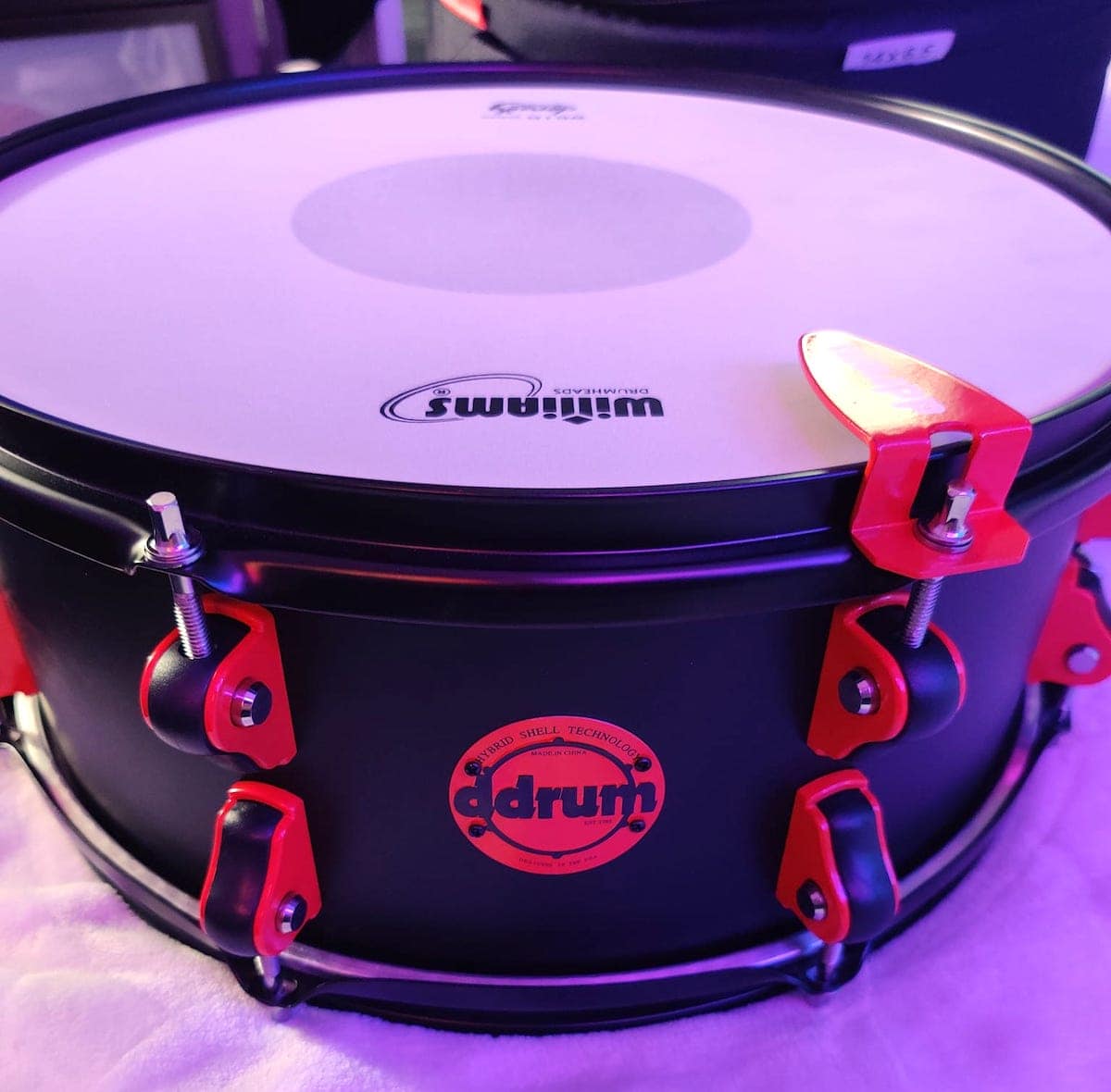
ddrum Hybrid Snare Drum
This snare just looks great! The black satin finish and red hardware accents make this a stand-out piece.
First I wanted to try this snare on its own, without trigger assistance. This is a birch shell snare so it sounds very bright and poppy!
Its 13” diameter also lends itself to a more condensed clean crack sound when struck, which I really liked. The snare acoustic sound is easy to dial in so you can get right to playing.
For fans of kits that sound big and boomy, they may find the snare too “small” sounding. If you would be one of those people, then may I suggest utilizing snare’s hybrid option?
After some digging, I found that the trigger used on this snare is a single-zone trigger based on ddrum’s Acoustic Pro Trigger line. I found the trigger to be accurate and a lot of fun to play with!
For those who might criticize the acoustic component of the snare for its lack of resonance or size, you can easily fill in that gap by utilizing the trigger audio interface.
Fortunately, this is my go-to snare for hip-hop when I want to layer sounds with vinyl samples. It works extremely well live, but I especially use it in the studio for hip-hop and lo-fi electronic music.
I love being able to process the acoustic birch sound while getting the full impact of the sampled one-shot, perfectly in phase and aligned with my acoustic snare. This has dramatically improved my production quality, as I no longer spend endless time in post-production trying to EQ, compress, and gate traditional acoustic sounds to match MPC vinyl snare samples.
Many hip-hop and electronic producers know this struggle — laying one-shot samples to beef up acoustic kits. It can be a nightmare and can destroy your groove if you're not careful.
We used to do this by manually slicing Rex loops or audio loops, grabbing snares from old Run-DMC or A Tribe Called Quest records, and manually aligning them on every snare hit in the session. You'd add the sliced-up snare you wanted to layer on another track.
Sometimes you'd get lucky and it would sound great, but other times the slightest flam or delay would cause your snare to lose punch due to phasing.
That's when companies saw an opportunity to create plugins for drum exchanging. I use the SPL drumXchanger from Plugin Alliance, which features phase alignment — there's no delay between when it detects your acoustic snare's transient and triggers your chosen sample.
Still, I would find myself manually editing all these triggered snares to fit properly, plus dealing with the challenge of blending the two different sounds.
This hybrid E-snare approach is far more intuitive and reliable. You save hours and avoid ear fatigue. Plus, it's a decent snare sound on its own — the birch has a tight, hip-hop-style crack that really complements dirtier vinyl sounds layered on top.
It works brilliantly for pop music too. You're not limited to dirty vinyl samples — you can use polished Max Martin-style snares or handclap-based snares, and the tightness and tone of this 13-inch snare suits that style perfectly when layered.
It's practically engineered for modern pop and hip-hop recording.
If you’re mainly seeking flexibility with the aesthetic presentation, then this is for you. If you want a more standard e-pad, then this would not be for you.
4. Roland PDA120LS
The Roland PDA120LS Drum Pad is a great alternative if you don't want to shell out the higher price for the PD-140 and don't need the extra 2 inches of playing surface to match a traditional snare.
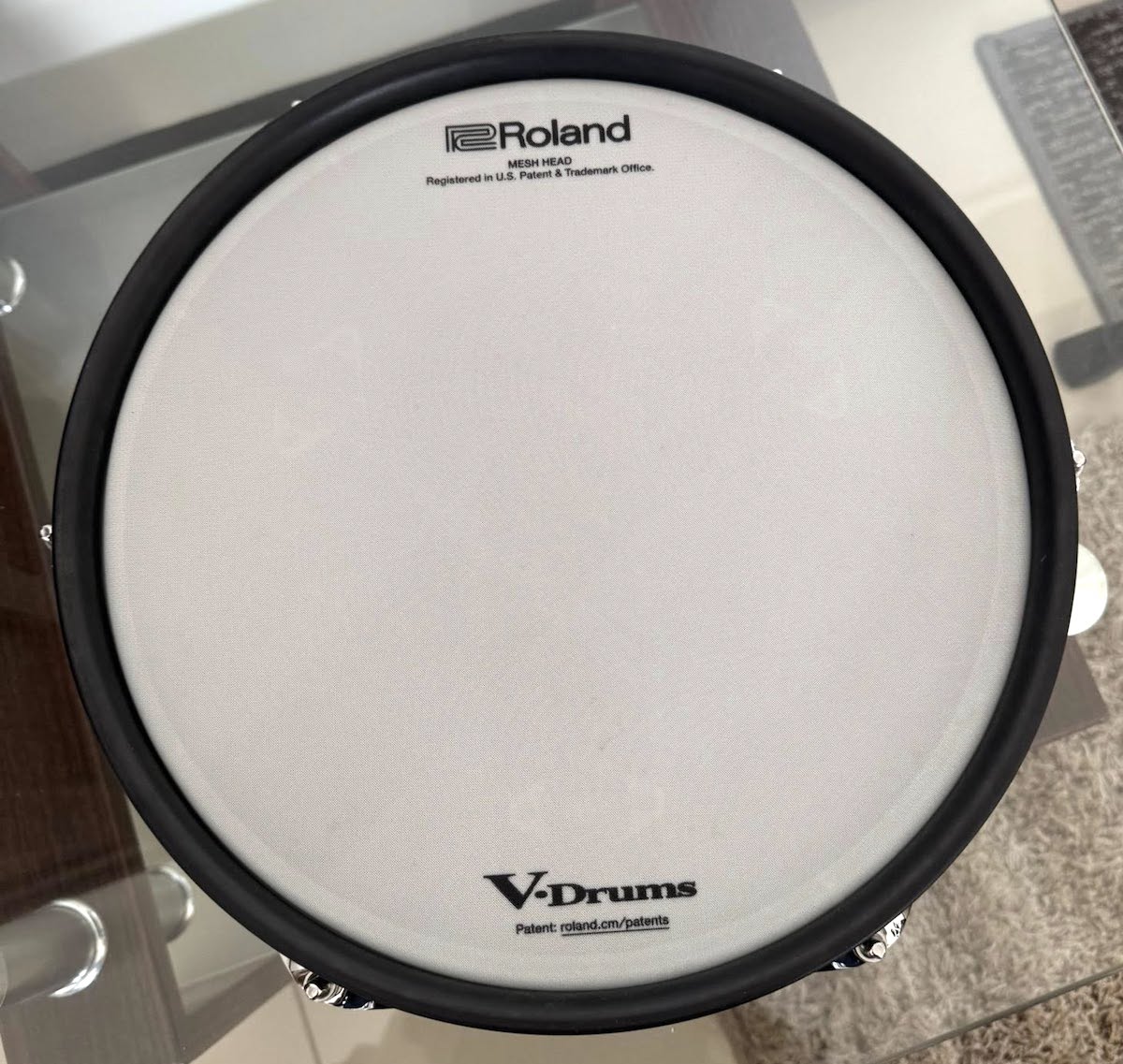
Roland PDA120LS Snare Drum
Unlike its bigger 14-inch sibling, it has a two-ply mesh head design with adjustable tension, letting you dial in the rebound and feel just like tuning an acoustic drum head. The 12-inch size is often easier to manage, especially when using multiple hybrid drum parts.
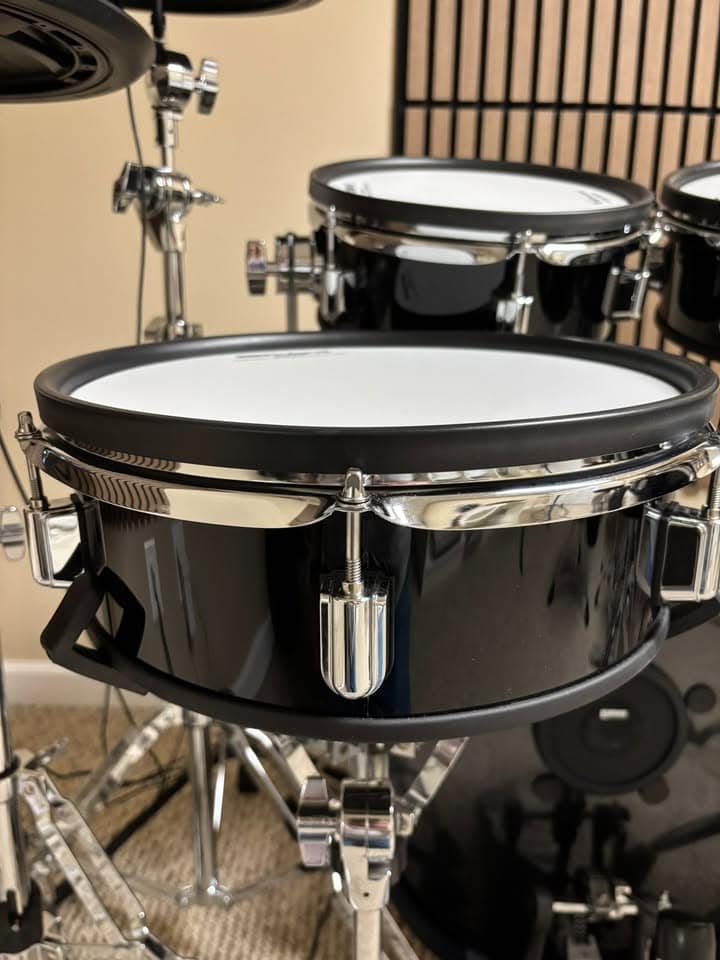
Roland PDA120LS Snare Drum as part of the VAD307 kit.
Coming from the same advanced line as the 14-inch model, this pad features highly sensitive dynamic sensors that deliver the same realism without the premium price tag. If you're going fully electronic and want to trigger an advanced module to sound exactly like an acoustic kit, this V-pad will do the job perfectly.
I use this pad with my electronic kit when playing film scores or Latin music, both in the studio and on stage. Even with acoustic kits at Latin gigs, I prefer smaller, tighter drums — I even have a cocktail kit specifically because I love using piccolo snares for Latin music.
Unlike rock or hip-hop, which often needs deeper, wider snares, Latin music and percussion relies on tight, crisp percussive elements. I sometimes remove the snare wires from my acoustic drum to get that calf-skin drum sound.
Since I enjoy triggering world ethnic drums, this kit is fantastic for live performances. I can layer African or Middle Eastern drums over my acoustic kit in a hybrid setup, or with an all-electronic setup, create custom kits where the kick remains traditional while the snare becomes a tabla or djembe.
I can assign different percussion to the remaining pads, and even set different sounds for the head and rim hits, creating unique real-time grooves.
These Roland V-pads with their two- and three-ply mesh designs deliver a satisfying attack that far surpasses the old rubber pads used as electronic triggers.
Here's a pro tip: position an SM57 microphone close to the snare trigger and run it through a harmonic compressor like the Empirical Labs Distressor (hardware or UAD plug-in) — you'll get fascinating sonic combinations when blending the mic with the trigger sound.
It's essentially creating your own hybrid snare with these V-pads.
There's no question that this snare is worth every penny, and it looks stunning too. The chrome with black edges resembles a vintage Ludwig or Gretsch snare, and its appearance perfectly suits its hip-hop credentials.
5. Yamaha XP80 DTX Series 3-Zone Drum Pad
The Yamaha XP80 DTX Series 3-Zone Drum Pad is what you'd expect from a traditional trigger pad. While less sophisticated than some alternatives, it delivers plenty of power as an add-on to any electric or acoustic kit.
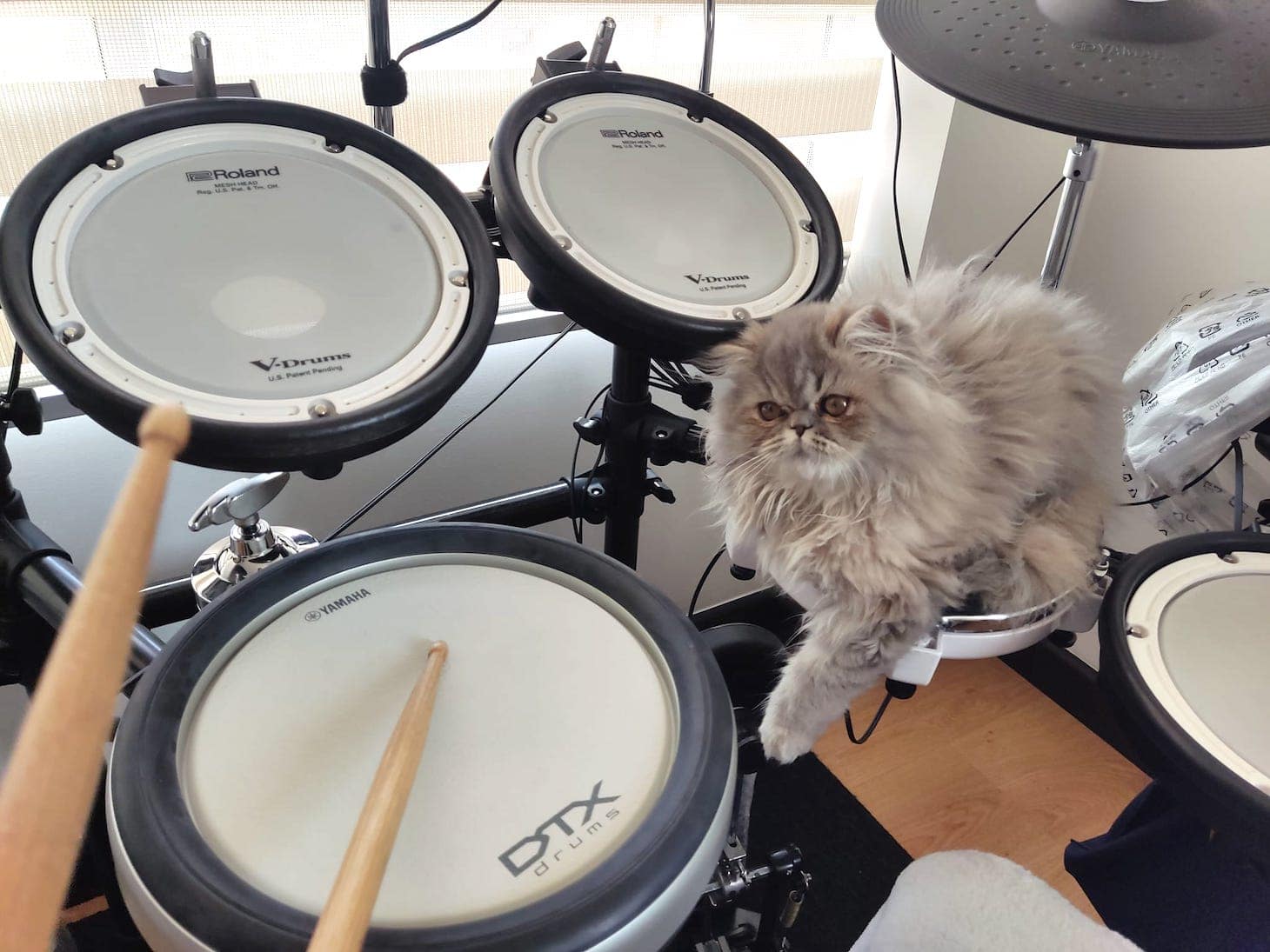
Yamaha XP80 - cat approved!
At 8 inches, the pad is compact enough to easily integrate multiple units around your kit. Don't let its small size fool you — it's far from simplistic.
It features a precise three-zone trigger that can be assigned to snare or tom open rimshot and closed rimshot. You can also route it via MIDI to trigger anything else, whether through Addictive Drums as a VST or to layer over an acoustic snare.
I mount these triggers on my crash stand to the right of my acoustic kit, usually with a snare sound loaded with effects and processing. I use the drum pad to trigger sounds with wobbles and extreme distortion, creating almost a dubstep-style effect.
On another pad, I'll run an ambient-style snare through an extremely long reverb using either my Eventide UltraVerb plug-in or Eventide Blackhole.
I use it this way because the small trigger space isn't ideal for recreating acoustic drum sounds. That's not its strength or purpose. Instead, I see it as a modern evolution of a high-quality classic trigger.
I prefer loading specific effect sounds that I can hit once and let them decay and tail off. With the synth-distorted snare, I might use it every other beat, or at the end of a phrase — playing my normal snare on beat two, then this effect snare before letting it tail off until the next bar, hitting it again at the end of beat four.
This creates cool, modern layering since I can strike it simultaneously with my main snare or toms.
During tom breakdowns or fills, I'll often use my left hand for the toms while my right hand strikes and alternates between the two effect samples.
Sometimes I'll skip the snare sample entirely, opting for an 808 sub kick or some high piercing sound. Layering these over your toms creates some incredibly cool modern textures.
What I love about these pads is how they push me to think like a composer or film scorer rather than a traditional drummer. Their compact size means I can mount multiple pads — I even have some on my left side near my hi-hat for triggering loops while playing my main snare.
Their precise 8-inch size is what makes them so versatile and effective.
For gigs with limited stage space, these pads paired with a small kick and acoustic hi-hat make for an awesome compact setup.
Whatever the case may be, there's always a use for a great, reliable electronic pad like this.
Can I Make My Own Hybrid Snare?
Marrying electronic and acoustic drums is a popular practice in the modern-day music scene. Drummers incorporate all sorts of samples in their playing to make for a more dynamic sound.
It is not entirely uncommon for drummers to convert acoustic shells they already have and replace their head and rim with an electronically triggered component. This snare trigger from ddrum is fairly popular.
You may already have most of the pieces you need. Check out YouTube for plenty of helpful videos which demonstrate how to do this in a short amount of time. This could save you money should you not want to rush out and buy a brand-new hybrid snare.
For more sophisticated multi-zone snares, like the advanced 14-inch Roland VP pad, this approach might not work well since the construction itself is part of what makes it sound so great.
It's not just about the number and placement of triggers — it also has a triple-ply mesh snare head that's perfectly calibrated for electronic triggers. If you want to achieve the most authentic acoustic kit sounds, a DIY solution probably won't cut it.
However, if you're just looking for a low-cost way to layer and trigger sounds to expand your kit, this could be a good path.
Can I Use Different Brand E-pads with My Kit?
This will require some research but, you will find a lot of e-kits that can utilize different brands of pads. Keep in mind this does not mean all!
Some brands have different inputs and outputs for certain functions. Other times the module won’t read the e-pad even though it’ll hook up just fine.
If you're going to be using e-pads in the studio to record, I find it best to just use a hybridized version of different manufacturer kits. For example, Roland, to me, has the best sounds in their modules, specifically the TD-50, while the ddrum hybrid snare has the best playing experience.
So if you have the luxury of layering several modules — all going through different preamps into a session or into a mixing board — then there's no need to just use the pad to trigger the same module.
My advice, if budget is no concern, is to pick the best sounds out of the different modules that originally come with the intended kit, almost the same way that you would trigger a variety of VST libraries to play different triggered drum sounds.
If you've never done that, I still think it's the best way to go.
For example, I sometimes use Addictive Drums for more indie rock sounds, but I really love BFD3 for jazz. Likewise, I use more Kontakt libraries for cinematic sounds, such as Spitfire Audio's The Grange drum kits as well as Hans Zimmer Percussion.
You should take the same philosophy with drum pads; most of these were engineered with their manufacturer's brand module in mind. In fact, the brush sweep precision of the roll in 14-inch V-Drum is almost exclusively for the Roland modules.
While they can trigger other properly mapped brush strokes through key maps, the precision it has with its own company's module is much tighter and precise.
Be sure to do your research, so that you don’t waste your money on something that doesn’t work.
Wrap Up
Whether you’re replacing your current e-pad or looking to integrate something into your acoustic kit with more function, there are a lot of great choices here.
Personally, I found the ddrum Hybrid snare to be a very exciting choice! It was something a little more foreign to me, but I loved utilizing it on its own or in tandem with the triggered effects. You can really liven up your snare with a trigger as a compliment to the organic sound.
The Roland V-Pad PD-140DS feels very authentic for an e-drum. A combination of some low-volume cymbals, an electronic kick pad, and this snare could make for some really fun practice time. I’d even venture to say you could play some small room gigs with that sort of setup as well.
More convenient options for e-kit users would include the other more traditional e-pad options from Roland and Yamaha. If seeking convenience for plug-and-play fun, then the more traditional route would be the path of least resistance to continue your e-drumming playtime.
Most importantly, I suggest exploring electronic snare drums to expand your creative capabilities. While you can recreate acoustic kits beautifully, especially in the studio, this new technology is meant to push sound and production boundaries further, not artificially replace real drums.
The tips I gave you about triggering unique samples of your own making can really open up your drum sound palette.
Playing with electronic drum pads changes how you think about grooving — much like how performing on a synthesizer, manually adjusting the filter cutoff knobs, and using physical touch strips for modulation affects your playing style and creative output.
It puts you in what I like to call a "production mindset," where you're thinking about creating grooves that sound more distinctive and interesting than what you might achieve with a traditional acoustic drum kit.
This is why electronic snare drums have become increasingly popular over the years. They should be seen as an exciting new instrument in their own right, rather than just a trigger or controller.
Much like how the synthesizer or electric piano was never meant to truly fool you into thinking you were hearing a grand piano. Instead, it was designed as an instrument that influenced "how" and "what" you played.
So try some of these kits and tricks for yourself — with a good groove, you'll go beyond anything you might expect!

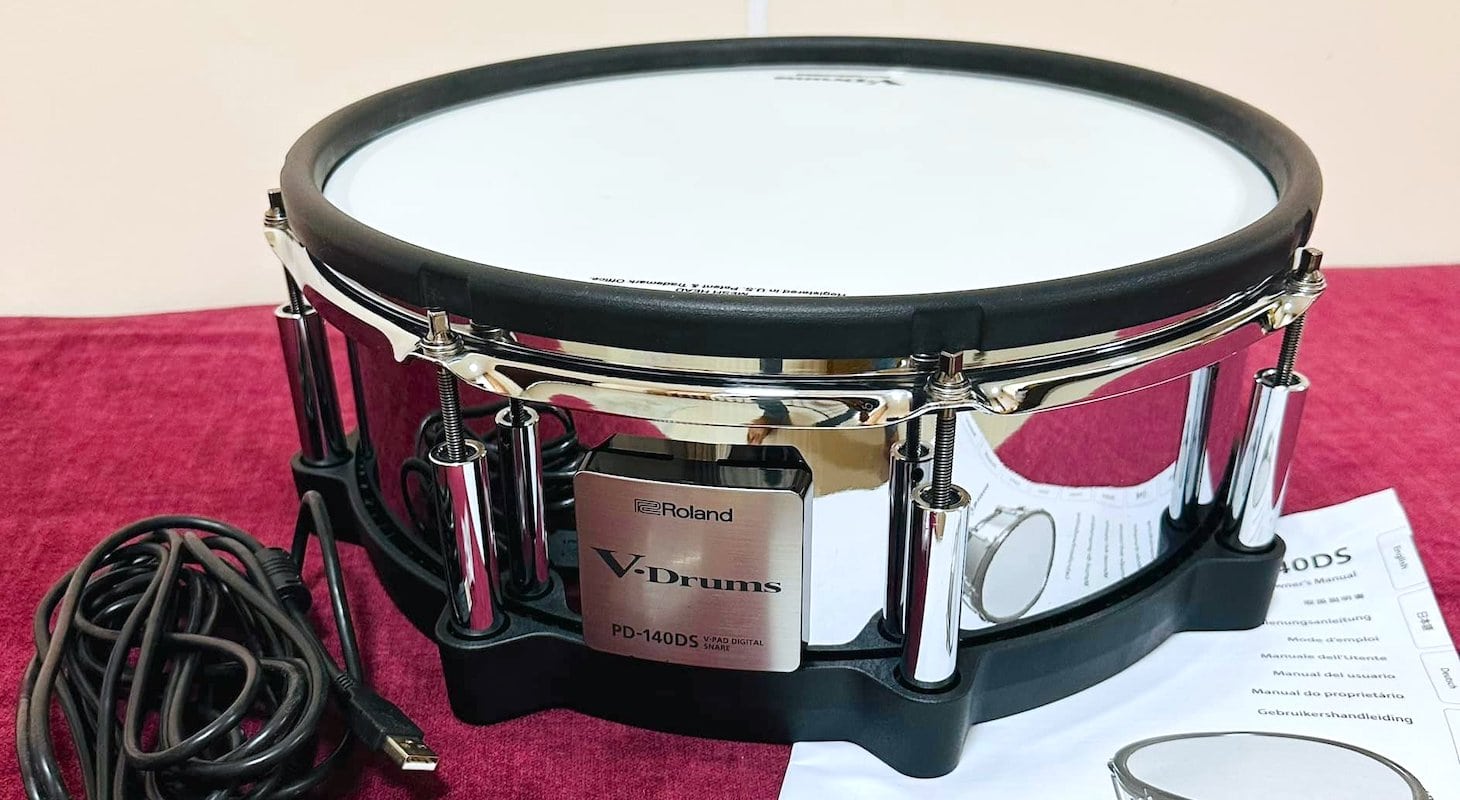




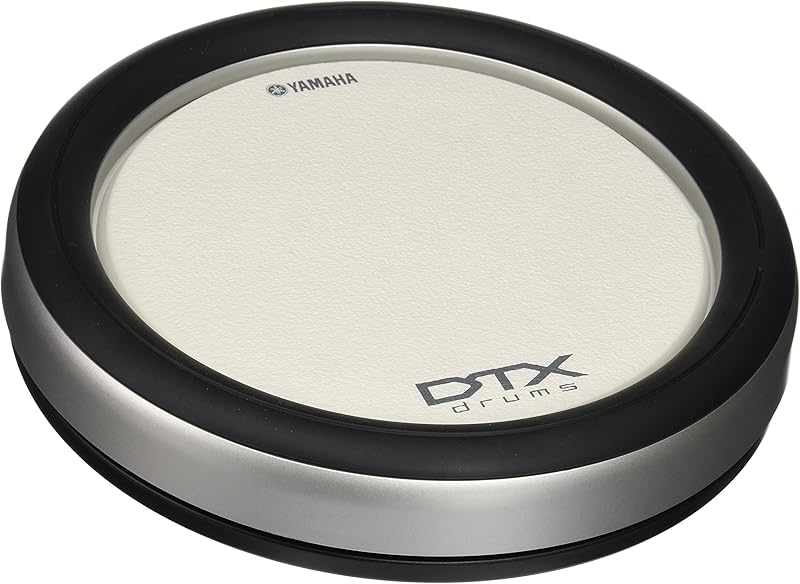
Great Read!I love the in depth tips.